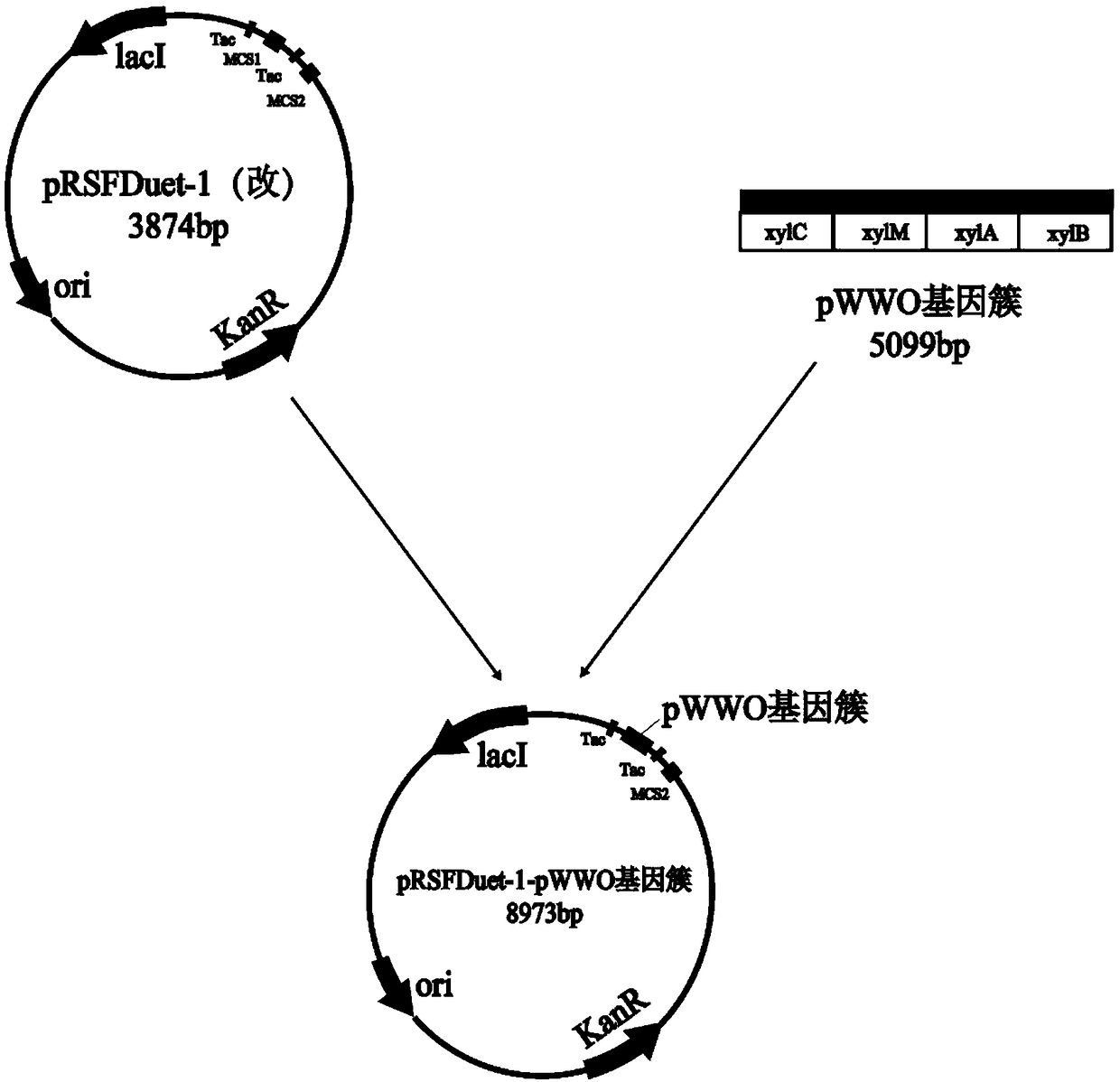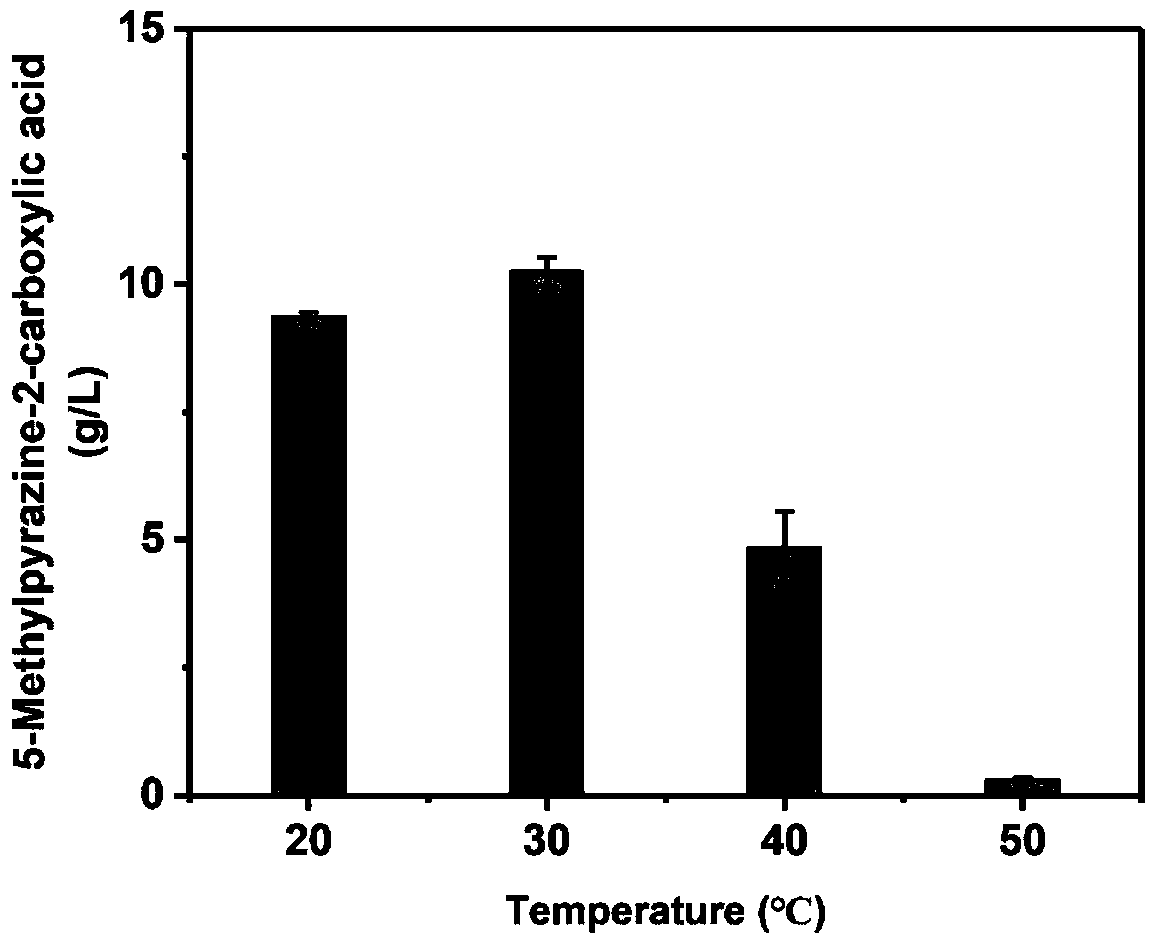Recombinant pseudomonas putida and application
A technology for the preservation of Pseudomonas putida and strains, which is applied in the field of fermentation engineering, can solve the problems of unfriendly environment and toxicity, and achieve the effects of less environmental pollution, mild reaction conditions, and easy promotion
- Summary
- Abstract
- Description
- Claims
- Application Information
AI Technical Summary
Problems solved by technology
Method used
Image
Examples
Embodiment 1
[0036] Example 1. Construction of recombinant plasmids
[0037] Pseudomonas putida published on NCBI P. putida Endogenous plasmid pWWO sequence of ATCC 33105 (NCBI accession NC_003350.1). Amplify the gene clusters encoding xylene monooxygenase (XO), benzyl alcohol dehydrogenase (BZDH) and benzaldehyde dehydrogenase (BADH) on pWWO, with 5'ATGCGGGAAACAAAAGAGCAG 3' as the upstream primer, 5'TCAACCAATCCGGAGTACCGGCTTAAGC 3 'PCR amplification for the downstream primers to obtain the target gene. Replace the original T7 promoter of pRSFDuet-1 with the Tac promoter, because Pseudomonas putida cannot express T7 RNA polymerase and cannot recognize the T7 promoter. Using the transformed pRSFDuet-1 plasmid as a template, the 5' CGGTACTCCGGATTGGTTGA GCATAATGCTTAAGTCGAACAG3' is the upstream primer, 5' TGCTCTTTTGTTTCCCGCAT GCCCATGGTATATCTCCTTATT3' is the downstream primer (the underline is the 20bp homologous sequence that is homologous to the target gene cluster added to the vector ...
Embodiment 2
[0038] Example 2. Construction of recombinant Pseudomonas putida
[0039] The recombinant plasmid pRSFDuet-1-pWWO gene cluster constructed in Example 1 was transformed into a cloning host E. coli JM109, pick a single colony grown on the kanamycin-resistant LB plate, PCR amplification, agarose gel electrophoresis confirmation, pick the positive clone to extract the plasmid, and then perform sequencing, and transform the expression host with the correct sequence P. putida ATCC 33105, Construction of recombinant bacteria P. putida JN-18.
Embodiment 3
[0040] Example 3. Gene clusters encoding xylene monooxygenase (XO), benzyl alcohol dehydrogenase (BZDH) and benzaldehyde dehydrogenase (BADH) in P. putida Expression in JN-18
[0041] The recombinant Pseudomonas putida obtained in Example 2 P. putida Pick a single colony of JN-18 from the plate containing kanamycin antibiotic, inoculate it into LB seed medium containing kanamycin antibiotic, and cultivate it at 30 °C and 220 rpm for 12 h as the seed liquid. Inoculate 2% (v / v) inoculum into TB fermentation medium containing kanamycin antibiotic, and culture at 30°C and 220 rpm until OD 600 =0.6, add IPTG with a final concentration of 0.2 mM, induce at 28°C for 10 h, and collect the bacteria by centrifugation for whole-cell catalysis.
PUM
 Login to View More
Login to View More Abstract
Description
Claims
Application Information
 Login to View More
Login to View More - R&D
- Intellectual Property
- Life Sciences
- Materials
- Tech Scout
- Unparalleled Data Quality
- Higher Quality Content
- 60% Fewer Hallucinations
Browse by: Latest US Patents, China's latest patents, Technical Efficacy Thesaurus, Application Domain, Technology Topic, Popular Technical Reports.
© 2025 PatSnap. All rights reserved.Legal|Privacy policy|Modern Slavery Act Transparency Statement|Sitemap|About US| Contact US: help@patsnap.com



